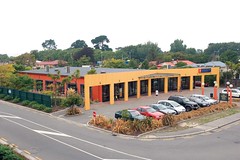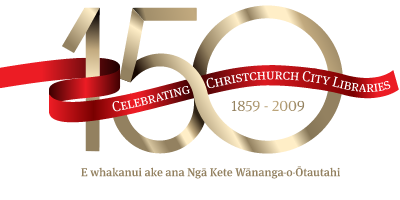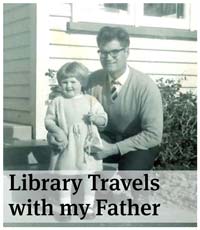Linwood Public Library: The Voluntary Years, 1909-1993
During the early years of the 20th century, community run libraries flourished in Christchurch. For many residents outside the central city area, access to the services and collections of Canterbury Public Library was limited.
 Linwood Library, one of the largest and most successful community run libraries was established by the Linwood Citizens Association under the leadership of Daniel Richardson a local timber and coal merchant.
Linwood Library, one of the largest and most successful community run libraries was established by the Linwood Citizens Association under the leadership of Daniel Richardson a local timber and coal merchant.
In 1909, the old Linwood Borough Council building on the corner of Stanmore and Worcester Streets was leased at a rental of 10 shilling per annum. The library building featured return gables, twin entries, sash windows, and coloured, geometrically patterned fanlights.
When the library was formally opened on 22 July by the mayor, Charles Allison, it had 960 books and between 40 and 50 subscribers. The subscription fee was set at 5 shillings per annum with each subscriber allowed one book per week. Initially the library opened on three evenings a week but high demand resulted in extended hours and by December 1909, it opened every week night.
With a commitment to foster the social benefits of reading, the library committee decided against establishing other fund-raising attractions, such as billiards, cards and evening entertainments. Instead, Linwood instituted a charge of 3d per volume for every additional book borrowed above the one a week allocated free to each subscriber.
By 1929, Linwood Library was, according to its annual report, the “most flourishing institution of its kind in Christchurch” with nearly 1800 subscribers and over 20,000 in its collection. The juvenile department, inaugurated in 1923 by Mr Reynolds in the hope of directing youth away from the distractions offered by “picture shows” and other entertainments was also well patronised. At the annual general meeting all agreed on the need for extensions or a new building. However, the Depression of the following years soon ended these aspirations.
 The management committee was proud of its non-fiction collection, frequently urging “inveterate” fiction readers to devote themselves to more “educational and informative literature”, some of which was “far more thrilling” than adventure stories, and provided “lasting memories” and a broader outlook on life. The library also stocked books on New Zealand and Maori history and fiction by New Zealand authors with a particular focus on Canterbury writers such as Ngaio Marsh, Edith Howes, Mona Tracy, Jessie Mackay, and Norman Berrow.
The management committee was proud of its non-fiction collection, frequently urging “inveterate” fiction readers to devote themselves to more “educational and informative literature”, some of which was “far more thrilling” than adventure stories, and provided “lasting memories” and a broader outlook on life. The library also stocked books on New Zealand and Maori history and fiction by New Zealand authors with a particular focus on Canterbury writers such as Ngaio Marsh, Edith Howes, Mona Tracy, Jessie Mackay, and Norman Berrow.
Despite the committee’s best efforts, membership began to fall off during the 1930s. The annual report of 1939 noted that “with greater spending power, the public is seeking amusements in directions other than reading”.
The opening of a free children’s library service in 1954 gave the library an injection of new membership with nearly 2000 children, aged 4-16, enrolled by 1958. This service was supported by Council rates through the Public Library, with books being purchased from a special fund. Problems began to compound in the 1960s, with the fall among both adult and juvenile subscribers.
The declining numbers of volunteer staff and the loss of books were the biggest problems faced by community run libraries in this period. Linwood had a large, mobile population, and many borrowers failed to return their books before moving out of the suburb.
Even more problematic was staffing. As women returned to the work force during the 1960s, it proved harder to find either committee members or volunteers for the adult and children’s libraries. Saturday hours ended in 1969 because no volunteers could be found, and in 1975, evening hours were reduced during the week for the same reason.
It became clear the community run system of suburban libraries was no longer able to meet the demand for professional library services from modern borrowers around the city. As early as the 1930s, there had been considerable debate about the pros and cons of a centralised library service in the city. Unlike many of the community run library committees, Linwood Library supported the idea of library reform.
 It was not until 1971 that the first suburban branch library in Spreydon was opened. Other branches followed in quick succession during the 1970s and 1980s but, as chief librarian Dorothea Brown noted in 1992, although a Linwood branch had been discussed as early as 1967, the eastern side of the city remained a blank spot on the library map.
It was not until 1971 that the first suburban branch library in Spreydon was opened. Other branches followed in quick succession during the 1970s and 1980s but, as chief librarian Dorothea Brown noted in 1992, although a Linwood branch had been discussed as early as 1967, the eastern side of the city remained a blank spot on the library map.
In November 1993 Linwood Public Library was finally opened in the new Eastgate shopping mall. The once flourishing community run library had by then become very small, yet for over eighty years had provided a valued and valuable community facility through countless hours of dedicated community run service.
- For a longer version of this article go to Linwood Public Library: The Voluntary Years, 1909-1993
- For more information about Linwood Library see our next article Linwood Library / Te Kete Wānanga o Ihutai



